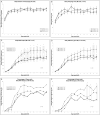Breast pump suction patterns that mimic the human infant during breastfeeding: greater milk output in less time spent pumping for breast pump-dependent mothers with premature infants
- PMID: 21818062
- PMCID: PMC3212618
- DOI: 10.1038/jp.2011.64
Breast pump suction patterns that mimic the human infant during breastfeeding: greater milk output in less time spent pumping for breast pump-dependent mothers with premature infants
Erratum in
- J Perinatol. 2012 Feb;32(2):160
Abstract
Objective: The objective of this study was to compare the effectiveness, efficiency, comfort and convenience of newly designed breast pump suction patterns (BPSPs) that mimic sucking patterns of the breastfeeding human infant during the initiation and maintenance of lactation.
Study design: In total, 105 mothers of premature infants ≤34 weeks of gestation were randomly assigned to 1 of 3 groups within 24 h post-birth. Each group tested two BPSPs; an initiation BPSP was used until the onset of lactogenesis II (OOL-II) and a maintenance BPSP was used thereafter.
Result: Mothers who used the experimental initiation and the standard 2.0 maintenance BPSPs (EXP-STD group) demonstrated significantly greater daily and cumulative milk output, and greater milk output per minute spent pumping.
Conclusion: BPSPs that mimic the unique sucking patterns used by healthy-term breastfeeding infants during the initiation and maintenance of lactation are more effective, efficient, comfortable and convenient than other BPSPs.
Conflict of interest statement
Conflict of Interest: Dr. Meier and Dr. Engstrom have received research funding and honoraria for projects from Medela, Inc. Ms. Janes, Ms. Jegier, and Ms. Loera declare no potential conflict of interest.
Figures
References
-
- Patel AL, Meier PP, Engstrom JL. The evidence for use of human milk in very low-birthweight preterm infants. NeoReviews. 2007;8(11):e459–66.
-
- Cregan MD, De Mello TR, Kershaw D, McDougall K, Hartmann PE. Initiation of lactation in women after preterm delivery. Acta Obstet Gynecol Scand. 2002;81(9):870–877. - PubMed
-
- Hill PD, Aldag JC, Chatterton RT, Zinaman M. Comparison of milk output between mothers of preterm and term infants: The first 6 weeks after birth. J Hum Lact. 2005;21(1):22–30. - PubMed
Publication types
MeSH terms
Grants and funding
LinkOut - more resources
Full Text Sources
Other Literature Sources
Medical
Research Materials





